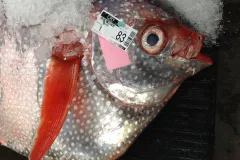“Storied Fish”: Why Sustainable Seafood Requires A Tale

Imagine sitting down at your favorite sushi restaurant. Your server arrives, laying before you a perfectly wrapped dragon roll, which comes adorned with a small square of rice paper resting on top of the spicy mayo. Taking out your phone, you scan the code written delicately in soy-based ink upon the rice paper and immediately your phone displays a description of the story behind the shrimp in your roll—where it was caught, how, and by whom. Assured that your dinner is from the well-managed and fair-labor US fishery of the Gulf of Mexico, you dive in, scarfing down the roll, rice paper label and all.
Though that scenario might sound like science fiction, Chef Rob Ruiz has put such edible QR codes into use at Harney Sushi in San Diego. And if you are more of the dine-at-home type, these same codes and detailed stories can be found on packaging of certain brands of seafood, too.
The ability for us to know the story of our seafood is a reality today. Unfortunately, it is also a rarity.
Despite the fact that we live in the “Information Age”, most of the seafood making its way to our plates is "mystery fish”—we get the fish, but little information about how that fish was caught, by whom, from where, or even the actual species. In North America, seafood is currently mislabeled one-third of the time! (PDF) This happens whether we purchase from a restaurant or a grocery store.
That lack of story creates a major problem: as long as mystery fish is the standard, shoppers can’t know whether the fish they're buying is the fish they think it is. In order to make sustainable choices we need to know what is on our plates. And sustainable choices are necessary to create the changes on the water that can ensure our wild fisheries will be around for generations to come. Like ocean ecosystems, seafood supply-and-demand systems are all linked.
One solution that we at Future of Fish have identified to this problem is to replace the mystery fish with a more “storied fish” like the kind we mention above.
"Storied fish" is seafood that comes with details about its journey from water to plate. Ultimately, it depends upon transparency and a paper trail (or digital record) that traces a fish back to where it originated. When such information is made available, it becomes possible for large buyers of fish—such as grocery store chains, restaurants, hospitals and universities—as well as individual consumers to support more responsibly caught fish. In an ideal world, where a variety of data is provided about a product, buyers can choose to purchase storied fish based on whatever values matter most to them, including factors such as whether the product is locally sourced, harvested with eco-friendly gear or produced using fair labor practices.
Making “storied fish” the norm requires improvements to traceability systems inside seafood companies that can better follow fish from water to the plate, as well as changes in policy. The good news is that efforts are currently underway to address both of these components. Meanwhile, many examples of storied fish already exist: the rise of Community Supported Fisheries (CSFs); an increasing number of seafood brands, such as Gulf Wild, or ThisFish, that put storied fish at the heart of their business models; university students working with their dining services to bring more local and sustainable seafood to their dining halls; and our own national roll-out of Future of Fish’s Sustainable Seafood Week. Storied fish are one of the great sources of #OceanOptimism out there.
While there is much to do before storied fish overtake mystery fish in grocery stores and restaurants, we’re off to a good start. To continue the progress, consumers can ask for the story behind their fish at the fish market or restaurant, which encourages seafood purchasers to demand the information themselves. Consumer pressure, combined with behind-the-scenes industry efforts, can work together to shift the global seafood system toward more sustainable practices.
Editor’s note: To learn more about storied fish visit www.sswnational.com.

